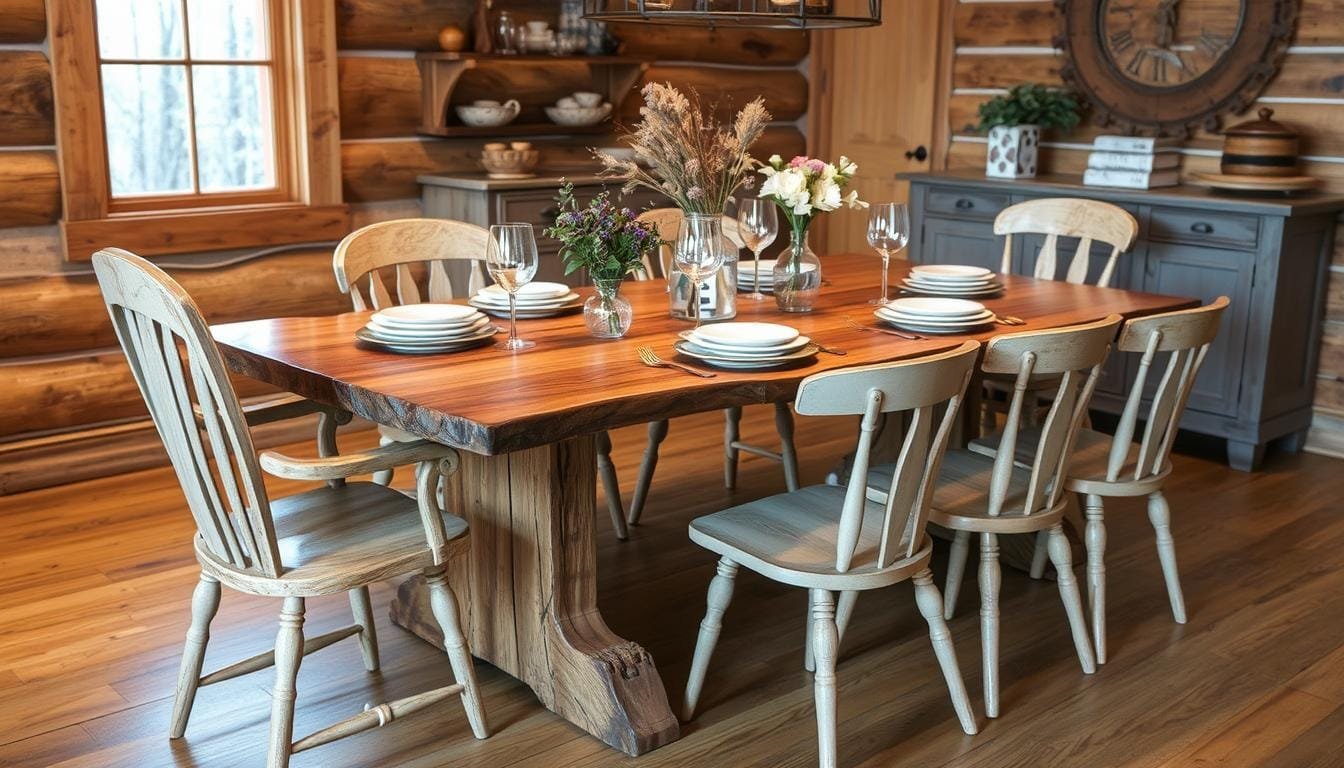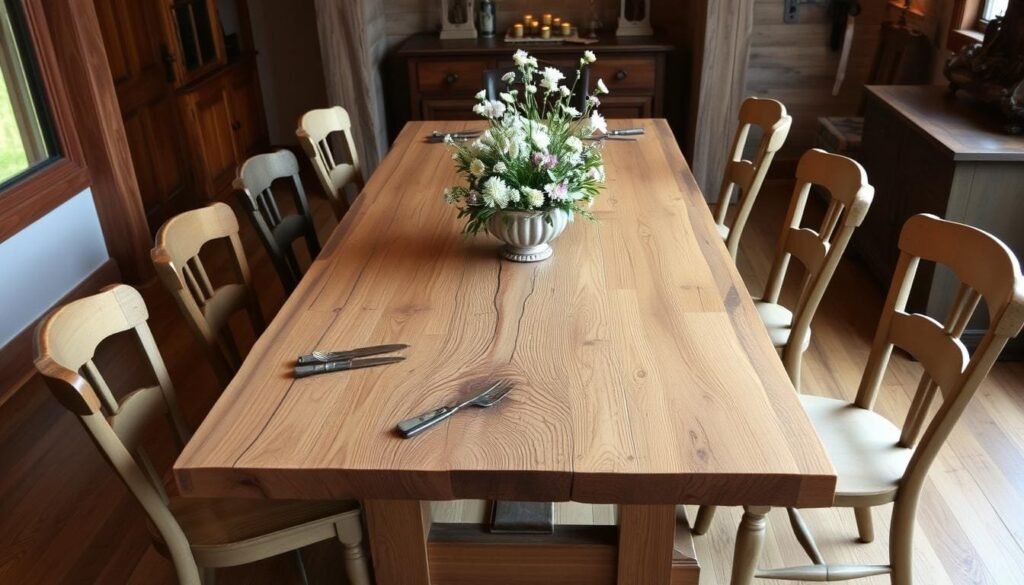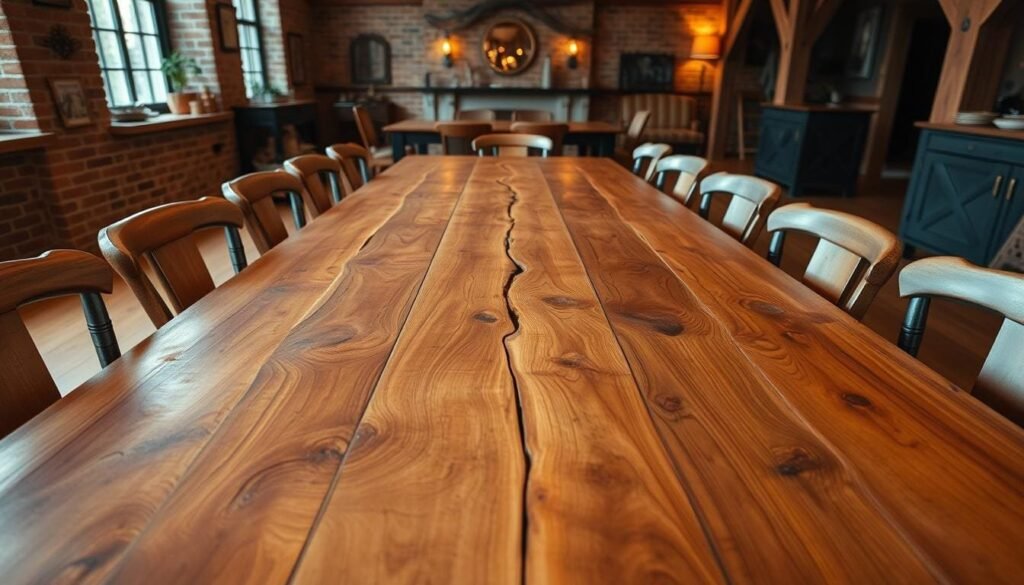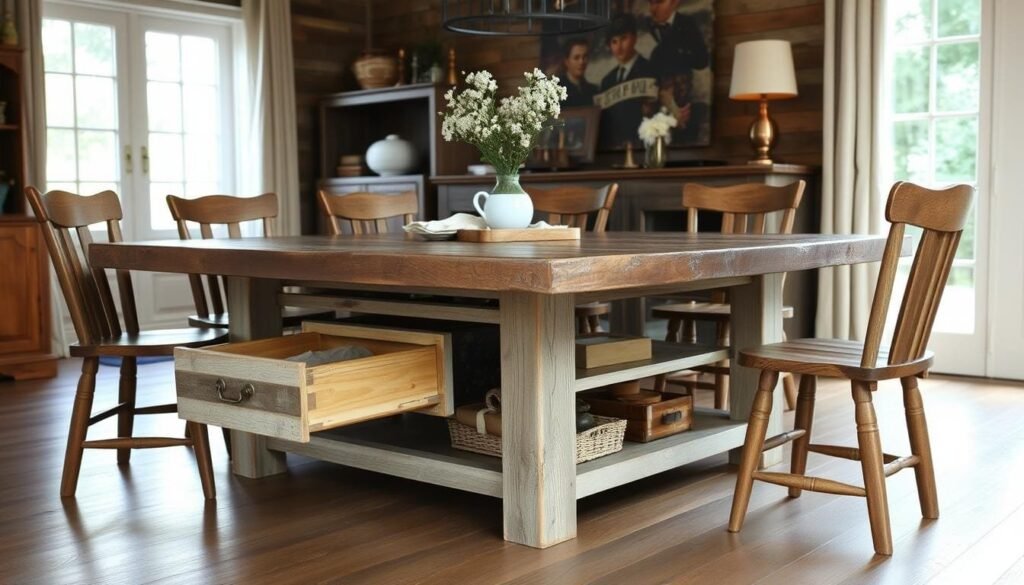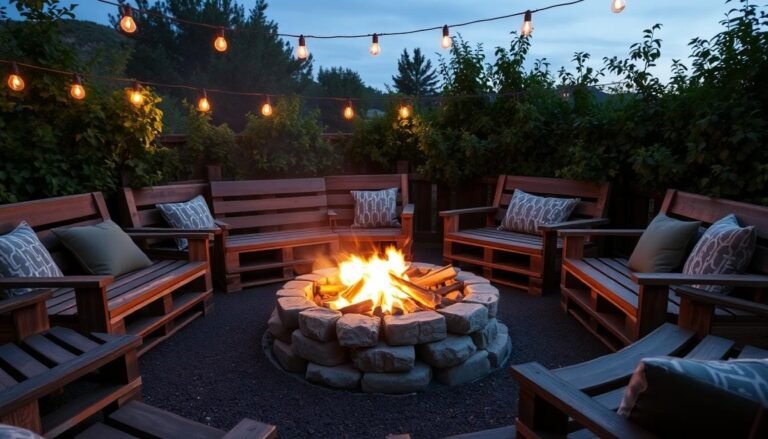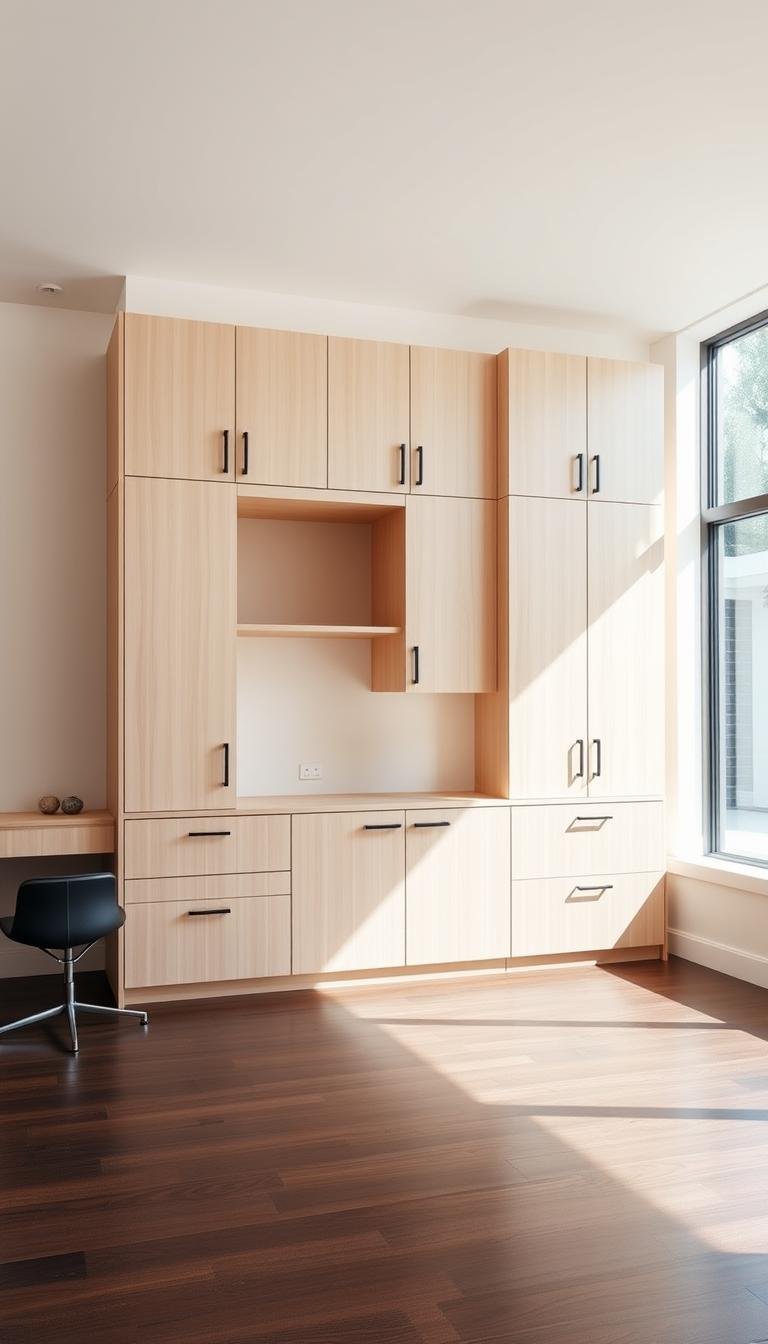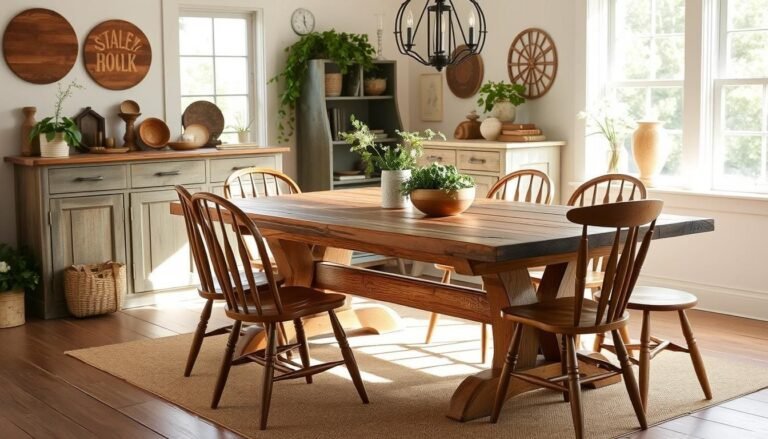This post may contain affiliate links. If you click and buy, we may earn a small commission at no extra cost to you. Learn more.
Elevate your dining experience with a handcrafted rustic dining table that exudes warmth, charm, and a touch of rustic elegance. Whether you’re furnishing a farmhouse-inspired space or seeking to infuse your modern home with a touch of natural character, building your own rustic dining table can be a rewarding and fulfilling project. This comprehensive guide will equip you with the knowledge and skills to create a stunning centerpiece that will leave your guests in awe.
Contents
- 1 Understanding Rustic Dining Tables and Their Appeal
- 2 Essential Tools for Building a Rustic Dining Table
- 3 Choosing the Right Wood for Your Rustic Table
- 4 Taking Measurements: Planning Your Table Size
- 5 Designing Your Rustic Dining Table
- 6 Building the Tabletop: Step-by-Step Guide
- 7 Constructing the Table Legs
- 8 Adding Rustic Details and Finishing Touches
- 9 Incorporating Storage Elements into Your Design
- 10 Enhancing Your Table with Accessories
- 11 Maintaining Your Rustic Dining Table
- 12 Hosting Tips for Showcasing Your Rustic Dining Table
- 13 FAQ
Key Takeaways
- Discover the defining features and appeal of rustic dining tables.
- Understand the essential tools and materials needed to build your own table.
- Learn how to choose the right wood and design your table to suit your space.
- Explore step-by-step instructions for constructing the tabletop and legs.
- Discover techniques to add rustic touches and maintain the longevity of your table.
Understanding Rustic Dining Tables and Their Appeal
In the world of home furnishings, rustic dining tables have captured the hearts of many. These timeless pieces, often crafted from reclaimed wood or featuring a farmhouse-inspired design, have gained a loyal following among homeowners seeking a touch of vintage charm in their dining spaces.
What Defines a Rustic Dining Table?
A rustic dining table is characterized by its natural, unrefined appearance. These tables typically feature a sturdy, distressed wood top that often showcases the unique grains and knots of the material. The legs and base may be made of wood or metal, adding to the overall vintage-style aesthetic.
The Materials Often Used
- Reclaimed wood: Rustic dining tables frequently incorporate reclaimed wood, such as barn wood or weathered boards, giving them a one-of-a-kind character.
- Solid wood: Pine, oak, and maple are popular choices for the construction of rustic dining tables, providing a durable and authentic look.
- Metal accents: Wrought iron or industrial-style metal elements are commonly used to complement the rustic aesthetic, adding visual interest and strength.
Why Choose Rustic Style?
The appeal of rustic dining tables lies in their ability to create a warm, inviting atmosphere in any dining room. These Farmhouse Tables and Vintage-Style Dining Tables seamlessly blend the past and present, offering a comfortable and cozy setting for gatherings with family and friends. Reclaimed Wood Tables in particular have become increasingly popular, as they not only add character but also promote sustainability by giving new life to reclaimed materials.
“Rustic dining tables bring a sense of timelessness and authenticity to any space, making them a cherished choice for those who value the beauty of imperfection.”
Essential Tools for Building a Rustic Dining Table
Crafting a stunning Handcrafted Wooden Table or Solid Wood Dining Room Set requires the right tools for the job. From essential hand tools to must-have power tools, having the proper equipment on hand is crucial for achieving professional-grade results. Let’s explore the essential tools needed to build your dream Rustic Dining Table.
Must-Have Hand Tools
- Carpenter’s pencil for precise marking and measuring
- Tape measure to ensure accurate dimensions
- Chisel set for shaping and finessing wood
- Hammer for driving in nails and securing joints
- Clamping tools to hold pieces in place during assembly
- Sandpaper in varying grits for a smooth finish
Power Tools You’ll Need
- Circular saw for efficient straight cuts
- Jigsaw for intricate and curved cuts
- Random orbital sander for a flawless surface
- Drill with various bits for drilling holes and joining components
- Router for adding decorative edges and details
Safety Gear to Keep in Mind
Woodworking can be a rewarding yet potentially dangerous hobby. Protect yourself by investing in essential safety gear, such as eye protection, ear protection, and a sturdy pair of gloves. Maintaining a clean and organized workspace is also crucial for minimizing the risk of accidents. With the right tools and safety precautions in place, you’ll be well on your way to creating your beautiful Handcrafted Wooden Table or Solid Wood Dining Room Set.
Choosing the Right Wood for Your Rustic Table
When it comes to creating a stunning Reclaimed Wood Tables or Solid Wood Dining Room Sets, the choice of wood is crucial. Rustic-style furniture often showcases the natural beauty and character of the wood, so selecting the right type can make all the difference in your final piece.
Popular Types of Wood
Some of the most commonly used woods for rustic dining tables include oak, maple, pine, and cedar. Each offers unique grain patterns, coloration, and durability that can complement the overall aesthetic. Oak, for instance, is known for its bold, prominent grains, while maple presents a more uniform and subtle appearance.
Considerations for Sustainability
In today’s eco-conscious world, many homeowners are seeking out sustainable wood options for their Reclaimed Wood Tables and Solid Wood Dining Room Sets. Reclaimed wood, salvaged from old barns, factories, or other structures, is a popular choice as it reduces waste and gives new life to discarded materials.
How to Source Quality Lumber
- Seek out local sawmills or lumber yards that specialize in high-quality, ethically sourced wood.
- Consider visiting nearby farms or ranches that may have access to fallen or repurposed trees.
- Research online retailers that offer a curated selection of sustainable and responsibly harvested wood.
By taking the time to carefully select the right wood for your rustic dining table, you can create a truly one-of-a-kind piece that will impress your guests and stand the test of time.
Taking Measurements: Planning Your Table Size
When building a captivating Rustic Dining Table or Farmhouse Table, understanding the standard dimensions is crucial. This knowledge will help you create the perfect piece that complements your space and accommodates your dining needs. Let’s explore the essential factors to consider when determining the ideal size for your rustic masterpiece.
Standard Dining Table Dimensions
Rustic Dining Tables and Farmhouse Tables typically range from 30 to 42 inches in width and 60 to 96 inches in length. The standard height for these tables is around 30 inches, allowing for comfortable seating and ample legroom. However, these measurements are not set in stone, and you can adjust them to suit your specific requirements.
Factors Influencing Size Choice
- Room Size: Measure the available floor space in your dining area to determine the maximum table dimensions that will fit comfortably.
- Seating Capacity: Consider the number of guests you’ll typically host and choose a table size that can accommodate them without feeling cramped.
- Aesthetic Preference: Opt for a table size that aligns with your desired rustic or farmhouse aesthetic, balancing functionality and visual appeal.
Sketching Your Design
Before you begin the building process, it’s a good idea to create a rough sketch of your Rustic Dining Table or Farmhouse Table. This will help you visualize the dimensions, proportions, and any unique features you want to incorporate. Take the time to experiment with different layouts and sizes to find the perfect fit for your space and your style.
“The key to a successful Rustic Dining Table or Farmhouse Table is finding the right balance between form and function.”
By considering the standard dimensions, evaluating the factors that influence your size choice, and sketching your design, you’ll be well on your way to creating a Rustic Dining Table that truly wows your guests.
Designing Your Rustic Dining Table
Creating a truly captivating rustic dining table requires more than just selecting the right materials. It’s about blending functionality with the aesthetic charm of Antique Dining Table Designs and Vintage-Style Dining Tables. By carefully considering the design elements, you can craft a piece that not only serves its purpose but also becomes the centerpiece of your dining space.
Sketching Your Vision
Start by visualizing your dream rustic dining table. Sketch out your ideas, taking inspiration from the timeless beauty of Antique Dining Table Designs and the allure of Vintage-Style Dining Tables. Experiment with different shapes, sizes, and distinctive features that will make your table stand out.
Balance Functionality and Aesthetics
As you design your rustic dining table, strive to find the perfect balance between functionality and aesthetics. Consider the practical aspects, such as the table’s dimensions, stability, and durability, while also incorporating design elements that capture the essence of a rustic aesthetic.
Custom Features to Consider
- Incorporate unique, hand-crafted details that add character, like intricate wood carvings or a distressed finish inspired by Antique Dining Table Designs.
- Explore custom-made table legs, such as chunky, tapered designs or rustic metal accents, to enhance the Vintage-Style Dining Tables vibe.
- Incorporate storage elements, such as drawers or shelves, to maximize functionality without compromising the overall rustic charm.
By thoughtfully designing your rustic dining table, you can create a piece that not only serves its practical purpose but also becomes a stunning focal point in your dining space, blending the timeless appeal of Antique Dining Table Designs and Vintage-Style Dining Tables.
Building the Tabletop: Step-by-Step Guide
Crafting the perfect Handcrafted Wooden Tables or Solid Wood Dining Room Sets begins with the foundation – the tabletop. In this step-by-step guide, we’ll walk you through the process of constructing a stunning tabletop that will wow your guests and become the centerpiece of your dining space.
Preparing the Wood
The first step in building the tabletop is to properly prepare the wood. Start by carefully selecting high-quality Handcrafted Wooden Tables or Solid Wood Dining Room Sets lumber, ensuring it is free of any major defects or blemishes. Once you have your wood, use a planer to smooth the surfaces and create a uniform thickness across all the planks.
Assembling the Planks
- Lay out the prepared planks and arrange them in the desired pattern or design. Aim for a balanced and visually appealing arrangement.
- Use wood glue to securely join the planks together, making sure to apply even pressure across the entire surface.
- Clamp the assembled tabletop and let the glue dry completely, following the manufacturer’s instructions.
Sanding Techniques for a Smooth Finish
With the tabletop assembled, it’s time to focus on creating a smooth, flawless finish. Begin with a coarse-grit sandpaper and work your way up to a finer grit, sanding in the direction of the wood grain. Ensure you sand all edges and corners for a seamless look.
To achieve a truly professional-grade finish, consider using a random orbital sander or a belt sander for the final passes. This will help to eliminate any remaining imperfections and leave your Handcrafted Wooden Tables or Solid Wood Dining Room Sets with a silky-smooth surface.
“The secret to a stunning tabletop lies in the details. Attention to preparation and sanding is key to creating a piece that radiates quality and craftsmanship.”
Constructing the Table Legs
Crafting the perfect Rustic Dining Table or Farmhouse Table goes beyond just the tabletop – the legs play a crucial role in the overall design and stability. When it comes to building the legs for your handcrafted masterpiece, you have several options to choose from.
Choosing the Type of Legs
The style of legs you select can have a significant impact on the final look and feel of your Rustic Dining Table or Farmhouse Table. Some popular choices include:
- Turned legs: These elegant, cylindrical legs add a touch of refinement to your table.
- Tapered legs: Slightly narrower at the bottom, tapered legs offer a sleek, modern aesthetic.
- Chunky, square legs: For a more robust, farmhouse-inspired look, consider thick, square-shaped legs.
- Live edge or natural legs: Incorporating the natural edge of the wood can create a truly unique, one-of-a-kind table.
Tips for Ensuring Stability
Regardless of the leg style you choose, it’s crucial to ensure your Rustic Dining Table or Farmhouse Table is stable and sturdy. Here are some tips to keep in mind:
- Use high-quality, seasoned wood to minimize warping or twisting over time.
- Opt for legs with a wide, solid base to distribute the table’s weight effectively.
- Consider adding cross-bracing or stretchers between the legs for extra stability and support.
- Carefully measure and align the legs to ensure your table sits level on any surface.
Attaching Legs Securely
Once you’ve selected the perfect legs for your Rustic Dining Table or Farmhouse Table, you’ll need to attach them securely to the tabletop. This step is crucial for ensuring the long-term durability and safety of your handcrafted piece. Here are some best practices for attaching the legs:
- Use sturdy hardware, such as lag bolts or metal brackets, to firmly secure the legs to the tabletop.
- Apply wood glue or epoxy to the leg-to-tabletop connection points for added strength and stability.
- Drill pilot holes to prevent the wood from splitting during the attachment process.
- Double-check the alignment and tightness of the leg connections before considering your table complete.
By carefully considering the leg design, stability, and attachment methods, you’ll be well on your way to creating a Rustic Dining Table or Farmhouse Table that not only looks stunning but also withstands the test of time.
Adding Rustic Details and Finishing Touches
When it comes to creating captivating Distressed Dining Furniture or Rustic Home Decor, the finishing touches can make all the difference. From wood staining options to distressing techniques, explore the various ways you can add authentic rustic charm to your handcrafted dining table.
Wood Staining Options
Staining your table is an effective way to achieve the desired Distressed Dining Furniture look. Consider a range of stain colors, from classic weathered grays to rich, warm browns, to complement your overall design vision. Experiment with techniques like applying multiple stain layers or using a combination of stains for a more nuanced, aged appearance.
Distressing Techniques for an Aged Look
- Purposeful denting and scratching: Use tools like hammers, chains, or sandpaper to create a lived-in, time-worn look on the table’s surface.
- Sanding and gouging: Strategically sand and gouge the wood to reveal the natural grain and create a sense of character and history.
- Burning and charring: Carefully apply controlled flames to the table’s edges and corners to achieve a charred, rustic aesthetic.
Sealing and Protecting Your Table
Once you’ve added all the desired rustic details, it’s crucial to seal and protect your Distressed Dining Furniture piece. Apply a high-quality polyurethane or lacquer finish to the table, ensuring a durable and long-lasting surface that can withstand everyday use. This final step will help preserve the unique character and beauty of your handcrafted Rustic Home Decor masterpiece.
“The beauty of rustic furniture lies in its imperfections, which add character and charm to any space.”
Incorporating Storage Elements into Your Design
When it comes to creating a rustic dining table, the options for storage and organization are as plentiful as the wood grains themselves. Whether you’re looking to showcase your antique cabin furniture or simply want to maintain a cohesive rustic aesthetic, incorporating storage elements can be a game-changer.
Shelves vs. Drawers: What to Choose
One of the primary decisions to make is whether to incorporate shelves or drawers into your rustic dining table design. Shelves offer a open and airy display, perfect for showcasing decorative pieces or storing everyday essentials, while drawers provide a more concealed storage solution, ideal for tucking away table linens, cutlery, or other dining accoutrements.
Creative Storage Solutions
- Incorporate built-in shelves along the table’s apron or base, creating a rustic and functional display.
- Design a table with a drawer beneath the tabletop, providing hidden storage for your dining needs.
- Opt for a table with a combination of shelves and drawers, offering the best of both worlds.
Maintaining a Rustic Look with Storage
The key to seamlessly integrating storage into your rustic dining table is to ensure it complements the overall aesthetic. Choose hardware, finishes, and materials that echo the table’s rustic charm, whether it’s weathered wood, wrought iron, or even repurposed metal. By carefully selecting your storage elements, you can create a cohesive and visually appealing design that showcases your love for Rustic Dining Tables and Cabin Furniture.
“A well-designed storage solution can transform a rustic dining table from functional to fabulous.”
Enhancing Your Table with Accessories
Transform your rustic dining table into a true showpiece by carefully selecting the right accessories. From tableware to centerpieces and lighting, the finishing touches can elevate the vintage-style ambiance and complement your Rustic Home Decor.
Selecting the Right Tableware
When it comes to tableware, opt for pieces that echo the rustic charm of your dining table. Consider earthy tones, natural textures, and simple patterns that won’t distract from the table’s main attraction. Stoneware, wooden plates, and linen napkins can all contribute to the desired aesthetic.
Centerpieces That Compliment the Rustic Look
- Natural elements like pinecones, river rocks, or dried flowers make for lovely centerpieces.
- Incorporate vintage-inspired candle holders or lanterns to create a warm, cozy atmosphere.
- Opt for a simple yet statement-making centerpiece, such as a wooden tray or a cluster of potted herbs.
Lighting Ideas for Ambiance
Lighting plays a crucial role in setting the mood for your Rustic Home Decor. Consider hanging vintage-style pendant lights or sconces above your Vintage-Style Dining Tables to cast a soft, inviting glow. Candles in rustic holders can also contribute to the overall ambiance, creating a cozy and intimate dining experience.
“The right accessories can transform a dining table into a stunning centerpiece that reflects your personal style and elevates the overall rustic ambiance.”
By carefully selecting your tableware, centerpieces, and lighting, you can create a harmonious and visually appealing Rustic Home Decor that will wow your guests and make your Vintage-Style Dining Tables the focal point of your dining space.
Maintaining Your Rustic Dining Table
Investing in a beautiful Solid Wood Dining Room Set or a stunning Reclaimed Wood Table is a rewarding experience. To ensure your rustic dining table maintains its charm and longevity, proper care and maintenance are essential. In this section, we’ll explore effective cleaning tips, repair methods for minor damages, and seasonal care recommendations to keep your table looking its best for years to come.
Cleaning Tips for Longevity
Regular cleaning is the key to preserving the natural beauty of your Solid Wood Dining Room Set or Reclaimed Wood Table. Use a soft, damp cloth to wipe down the surface, avoiding harsh chemicals or abrasive cleaners that can damage the wood. For tougher stains, try a mild soap and water solution, followed by a gentle buffing with a dry cloth. Remember to clean in the direction of the wood grain to maintain a seamless, polished appearance.
Repairs for Dings and Scratches
- Addressing minor dings and scratches can help maintain the pristine look of your rustic table. For small dents, use a wood putty or filler that matches the color of your table, gently sanding it flush once dry.
- Deeper scratches can be filled with a matching wood stain or marker, blending the affected area to match the surrounding surface.
- If the damage is more severe, it’s best to consult a professional furniture repair specialist who can provide expert guidance and ensure the integrity of your Solid Wood Dining Room Set or Reclaimed Wood Table.
Seasonal Care Recommendations
- Summer: Protect your table from direct sunlight and humidity, which can cause the wood to warp or discolor over time. Use coasters and tablecloths to shield the surface.
- Fall: As temperatures cool, apply a thin layer of wood conditioner or oil to help the table retain its moisture and prevent drying or cracking.
- Winter: During the colder months, avoid placing your table near heat sources, as sudden temperature changes can be detrimental to the wood.
- Spring: Gently clean and condition your table, preparing it for the warmer seasons and ensuring it remains in optimal condition.
By following these maintenance tips, you can enjoy your Solid Wood Dining Room Set or Reclaimed Wood Table for many years to come, preserving its rustic charm and timeless appeal.
Hosting Tips for Showcasing Your Rustic Dining Table
When it comes to entertaining guests, your exquisite rustic dining table offers the perfect canvas to create a captivating dining experience. From setting the stage for a beautiful scene to planning themed gatherings, there are countless ways to showcase the rugged charm of your farmhouse-inspired centerpiece.
Setting a Beautiful Dining Scene
Begin by thoughtfully arranging your table with natural elements that complement the rustic aesthetic. Opt for crisp white linens, weathered wood chargers, and vintage-inspired dishware to enhance the farmhouse ambiance. Incorporate seasonal florals or organic greenery as a stunning centerpiece, allowing the grain and character of your table to shine through.
Themed Dinner Ideas
Elevate the experience by embracing themed dinner parties that celebrate the rustic charm of your dining table. Transport your guests to a cozy cabin with a “Fireside Feast,” featuring hearty comfort foods and warm lighting. Alternatively, create a “Farm-to-Table” experience, showcasing locally sourced ingredients and rustic presentation. These thematic elements will surely captivate your guests and leave a lasting impression.
Engaging Your Guests with the Rustic Vibe
Encourage your guests to fully immerse themselves in the rustic atmosphere by incorporating interactive elements into your hosting. Encourage them to share stories around the weathered table, or challenge them to a friendly game of cards using a vintage-inspired deck. By fostering a convivial ambiance, you’ll allow your guests to truly appreciate the warmth and character of your beloved rustic dining table.
FAQ
What defines a rustic dining table?
A rustic dining table is characterized by its use of natural, often reclaimed, materials like solid wood, especially distressed or weathered wood. These tables typically feature a rugged, handcrafted aesthetic that evokes a warm, inviting farmhouse or cabin-inspired style.
What are the common materials used for rustic dining tables?
Rustic dining tables are commonly made from solid wood, such as reclaimed wood, pine, oak, or cedar. The wood may have a distressed, weathered, or vintage appearance to achieve the desired rustic look.
Why are rustic dining tables becoming increasingly popular?
Rustic dining tables are appealing because they offer a warm, inviting, and timeless aesthetic that complements various home design styles, from farmhouse to industrial. Their natural, handcrafted charm adds character and ambiance to any dining space.
What are the essential tools needed for building a rustic dining table?
Some of the must-have tools for building a rustic dining table include hand tools like saws, sanders, clamps, and chisels, as well as power tools like a table saw, orbital sander, and drill. It’s also important to have the proper safety gear, such as eye protection and gloves.
How do I choose the right wood for my rustic dining table?
When selecting wood for a rustic dining table, consider factors like sustainability, availability, and the desired aesthetic. Popular options include reclaimed wood, pine, oak, and cedar, each with its own unique grain patterns and characteristics.
What are the standard dimensions for a rustic dining table?
Typical rustic dining table dimensions range from 36 to 42 inches in width and 60 to 84 inches in length, accommodating 4 to 8 people. The height is usually 29 to 31 inches. However, these measurements can be adjusted based on the size of your dining space and the number of guests you want to accommodate.
How do I design a custom rustic dining table?
When designing a custom rustic dining table, start by sketching your vision and considering factors like balance, functionality, and aesthetic. You can incorporate unique features such as live edges, metal accents, or built-in storage to personalize your table and make it a true focal point in your dining room.
What are some tips for building the tabletop of a rustic dining table?
To build the tabletop of a rustic dining table, focus on proper wood preparation, efficient plank assembly, and careful sanding techniques. This will ensure a smooth, sturdy surface that showcases the natural beauty of the wood.
How do I construct the legs for a rustic dining table?
When constructing the legs for a rustic dining table, consider different leg styles, such as tapered, square, or turned legs. Ensure the legs are stable and securely attached to the tabletop for a sturdy and well-balanced table.
What are some ways to add rustic details and finishing touches?
Adding rustic details and finishing touches can include techniques like wood staining, distressing, and sealing the table to achieve an authentic, aged appearance. These finishing touches help enhance the overall rustic aesthetic of your dining table.
How can I incorporate storage elements into my rustic dining table design?
Rustic dining tables can be designed with built-in storage solutions, such as shelves or drawers, to provide additional functionality and storage space. When incorporating these elements, be mindful of maintaining the overall rustic look and feel of the table.
What accessories can I use to enhance my rustic dining table?
Complement your rustic dining table with appropriate tableware, centerpieces, and lighting choices. These accessories can include vintage-inspired dishes, natural fiber or wood accents, and warm, ambient lighting to create a cohesive, rustic-inspired dining experience.
How do I properly maintain my rustic dining table?
Proper maintenance of a rustic dining table includes regular cleaning, addressing minor repairs like dings or scratches, and applying seasonal care, such as conditioning the wood. These steps will help preserve the table’s beauty and ensure its longevity.
How can I showcase my rustic dining table when hosting guests?
To showcase your rustic dining table when hosting, focus on setting a beautiful dining scene with appropriate tableware and decor. Consider themed dinner ideas that complement the rustic aesthetic, and engage your guests by highlighting the unique features and story behind your handcrafted table.
Looking for More Woodworking Projects? 🛠️
If you’re passionate about woodworking and ready to tackle a variety of projects, Ted’s Woodworking Plans offers over 16,000 detailed plans for all skill levels. From furniture to garden projects and everything in between, these plans include step-by-step instructions, materials lists, and 3D schematics to make every build easier.
Whether you’re a beginner or experienced woodworker, this collection is an incredible resource to expand your skills and bring your ideas to life. Click below to explore Ted’s Woodworking Plans and discover your next project!

To bring you cozy inspiration more efficiently, we sometimes use AI to assist in content creation — but every word and idea is carefully shaped by our team. See our AI Disclosure for more info.

